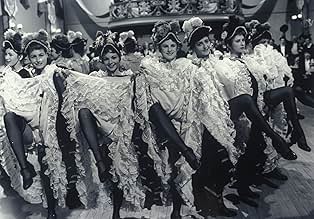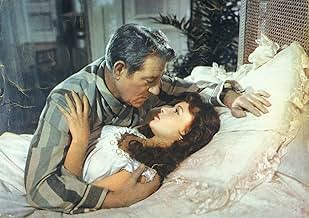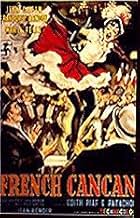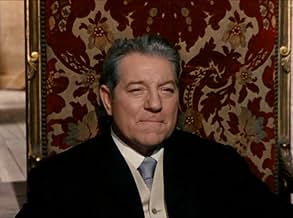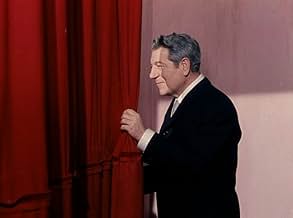CALIFICACIÓN DE IMDb
7.3/10
4.7 k
TU CALIFICACIÓN
El renacimiento del baile más famoso de París y cuenta la historia de un productor de teatro que convierte a una humilde lavandera en una estrella en el Moulin Rouge.El renacimiento del baile más famoso de París y cuenta la historia de un productor de teatro que convierte a una humilde lavandera en una estrella en el Moulin Rouge.El renacimiento del baile más famoso de París y cuenta la historia de un productor de teatro que convierte a una humilde lavandera en una estrella en el Moulin Rouge.
- Dirección
- Guionistas
- Elenco
- Dirección
- Guionistas
- Todo el elenco y el equipo
- Producción, taquilla y más en IMDbPro
Opiniones destacadas
The story is simple but the execution is marvelous. A Belle Epoque impresario, down on his financial luck, is going to open a new club, the Moulin Rouge, with a new dance, the French cancan. He encounters a working girl and makes her a dancer. She'll become a star. There are several crises to overcome before that happens.
The movie is Jean Renoir's tribute to show business, and he puts it on the screen with color, verve, humor, and humanity. There are wonderful performances by all the actors. The leads are Jean Gabin as Henri Danglard, the impresario; Francoise Arnoul as Nini, the girl who'll become a star; and Maria Felix as Lola de Castro, an overwhelmingly tempestuous beauty and Danglard's lover at the start. Gabin exudes confidence, worldly humor and dedication to show business. He even dances a bit. Arnoul is first rate, too. It looks like she was doing her own dances, and as an actress think of a young Leslie Caron with brains and charm.
The climax of the movie is the opening of the club, with Felix's star dance, comic songs, a whistler, a Danglar-discovered singer, all moving toward the introduction of the French cancan. The crises happen and are resolved. Then the cancan explodes. Dancing girls come bursting out from the stage, the front of the theater, through posters, down ropes from the balcony. The house swirls with the black tie and tails of the swells and the garish colors of the dancers' gowns. The cancan number lasts probably ten or fifteen minutes or so, all music and gaiety, all high kicks and splits. It's amazing when row after row of the dancers, moving toward the camera through the audience, leap up, legs extended straight forward and backward, backs arched, then land on the dance floor in full splits. I didn't know whether to shout or wince.
The last scene of the movie is outside the club, shot from the cobblestone street looking at the entrance. It's a medium shot and from the side street a happy, inebriated fellow in black tie and top hat staggers across, pauses to tip his hat at the camera, then staggers off. A completely charming ending.
This really is a marvelous movie.
The movie is Jean Renoir's tribute to show business, and he puts it on the screen with color, verve, humor, and humanity. There are wonderful performances by all the actors. The leads are Jean Gabin as Henri Danglard, the impresario; Francoise Arnoul as Nini, the girl who'll become a star; and Maria Felix as Lola de Castro, an overwhelmingly tempestuous beauty and Danglard's lover at the start. Gabin exudes confidence, worldly humor and dedication to show business. He even dances a bit. Arnoul is first rate, too. It looks like she was doing her own dances, and as an actress think of a young Leslie Caron with brains and charm.
The climax of the movie is the opening of the club, with Felix's star dance, comic songs, a whistler, a Danglar-discovered singer, all moving toward the introduction of the French cancan. The crises happen and are resolved. Then the cancan explodes. Dancing girls come bursting out from the stage, the front of the theater, through posters, down ropes from the balcony. The house swirls with the black tie and tails of the swells and the garish colors of the dancers' gowns. The cancan number lasts probably ten or fifteen minutes or so, all music and gaiety, all high kicks and splits. It's amazing when row after row of the dancers, moving toward the camera through the audience, leap up, legs extended straight forward and backward, backs arched, then land on the dance floor in full splits. I didn't know whether to shout or wince.
The last scene of the movie is outside the club, shot from the cobblestone street looking at the entrance. It's a medium shot and from the side street a happy, inebriated fellow in black tie and top hat staggers across, pauses to tip his hat at the camera, then staggers off. A completely charming ending.
This really is a marvelous movie.
Acknowledgments to Cole Porter from whose lyric CanCan (the title song of his 1953 Broadway show of the same name) I take my one line summary. This is, purely and simply, a Valentine to Paris, the Belle Epoque, the Impressionists, you-name-it. As such it is both stunning and sumptuous.Gabin - who began in the French Music Halls - is superb, but then when isn't he, Arnoul is a revelation. More? Well, the photography is ... the music is ... the ambience is ... aw, what the hell, go see it, do yourself a great big favor. 9/10
"French Cancan" is one of my favorite all time movies. It's an excellent film. There's color, there's humor, there's music. It's a very good portrait of the so called Belle Époque, though Jean Renoir's priorities were always to show a creation, a fantasie. So the film isn't a historical movie. The final sequences in which the girls dance cancan are unforgettable images. It's a film you shouldn't miss.
10bob998
This is my favorite Renoir from the Fifties. It's the story of how Henri Danglard built and launched the Moulin Rouge nightclub; we see the workmen blasting at the site to get construction underway, and the training of the dancers. Finally, the giddiness of opening night and the long sequence of cancan dancing. Financial problems and the ego displays of the performers are described.
Gabin is in great form as the easy-going Danglard--see him deal humorously with Nini's violent boyfriend. Gianni Esposito is moving as the wistful Prince who is courting Nini. Maria Felix, with that amazon's body, is imposing as the egotistical Lola, Danglard's first lover. Finally Françoise Arnoul as Nini the washing girl who ends up dancing for Danglard, and becoming his girl, is just stunning; her loveliness and pert charm will win you over.
A bonus: we get Edith Piaf, Patachou, André Claveau and other stars in cameos playing the stars of a century ago who ruled over the Moulin rouge.
Gabin is in great form as the easy-going Danglard--see him deal humorously with Nini's violent boyfriend. Gianni Esposito is moving as the wistful Prince who is courting Nini. Maria Felix, with that amazon's body, is imposing as the egotistical Lola, Danglard's first lover. Finally Françoise Arnoul as Nini the washing girl who ends up dancing for Danglard, and becoming his girl, is just stunning; her loveliness and pert charm will win you over.
A bonus: we get Edith Piaf, Patachou, André Claveau and other stars in cameos playing the stars of a century ago who ruled over the Moulin rouge.
I watched this movie three times at different ages of my life and always did enjoy it very much indeed. This Can-Can is an authentic explosion of joie de vivre, like Stanley Donen and Gene Kelly musical, but in French way. And a Jean Renoir nice tribute to his time, his friends, lovers, music and dances. It is at same time a show business chronicle of that age, full of affection and French mood. It is too a clear tribute to the Impressionism (people who likes impressionistic painters will like this picture). It is particularly a tribute to Toulouse-Lautrec and, of course, to Jean Renoir father, Pierre-Auguste. You will find hear a trustworthy and splendid colored recreation of some Renoir master work. Excellent casting, scenery, sound-effects and music. Even it tell us about the creation of Parisian Moulin Rouge, obviously it is a fiction story (and not very original by the way, as it fall down in the very well know moral that the show must go on). But the Jean Renoir production is great.
¿Sabías que…?
- TriviaThe on-screen singer of "La complainte de la Butte" is not Cora Vaucaire (credited in the titles) as she was deemed not good-looking enough to appear on film, so Italian actress Anna Amendola was put in front of the camera and mimed to the song...
- Citas
Henri Danglard: Do I look like Prince Charming? Only one thing matters to me - what I create.
- Versiones alternativasOriginally released in the US in 1956 at 93 minutes; ten minutes of footage removed from the original French version were reinstated for 1985 reissue.
- ConexionesFeatured in Viaje por el cine francés (2016)
Selecciones populares
Inicia sesión para calificar y agrega a la lista de videos para obtener recomendaciones personalizadas
- How long is French Cancan?Con tecnología de Alexa
Detalles
- Fecha de lanzamiento
- Países de origen
- Idioma
- También se conoce como
- Only the French Can
- Locaciones de filmación
- Productoras
- Ver más créditos de la compañía en IMDbPro
Taquilla
- Total a nivel mundial
- USD 10,799
- Tiempo de ejecución1 hora 42 minutos
- Color
Contribuir a esta página
Sugiere una edición o agrega el contenido que falta

Principales brechas de datos
By what name was French Cancan (1955) officially released in India in English?
Responda
![Ver Bande-annonce [VO]](https://m.media-amazon.com/images/M/MV5BMDIzNTViZDUtMTQ0MC00MDExLWFkNzYtNjJhMDlkN2YzMDRjXkEyXkFqcGdeQXRyYW5zY29kZS13b3JrZmxvdw@@._V1_QL75_UX500_CR0)
